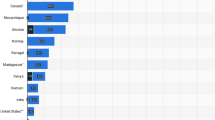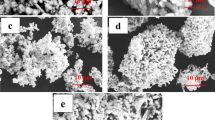Information about calcium zirconate is presented. The areas of its use and methods of obtaining it are considered. It has been established that the simplest and most cost-effective method is solid-phase synthesis from calcium carbonate and zirconium dioxide. Heat treatment of a mixture of the initial powders at different temperatures was carried out. It has been established that 1300°C for 4 hours is enough for completeness of the synthesis. The resulting powder has activity to sintering and is suitable for manufacturing technical ceramics and refractories, including for smelting and sintering materials made of titanium and titanium alloys.





Similar content being viewed by others
References
S. Schaffoner, C. G. Aneziris, H. Berek, B. Rotmann, and B. Friedrich, “Investigating the corrosion resistance of calcium zirconate in contact with titanium alloy melts,” J. Eur. Ceram. Soc., 35(1), 259 – 266 (2015).
S. K. Kim, T. K. Kim, M. G. Kim, T.W. Hong, and Y. Kim, “Investment casting of titanium alloys with CaO crucible and CaZrO3 mold,” Lightweight Alloys Aerosp. Appl., Proc. Symp., 2001, pp. 251 – 260.
S. Schaffoner, T. Qin, J. Fruhstorfer, C. Jahn, G. Schmidt, H. Jansen, and C. G. Aneziris, “Refractory castables for titanium metallurgy based on calcium zirconate,” Mater. Des., 148, 78 – 86 (2018).
U. E. Klotz, C. Legner, F. Bulling, et al., “Investment casting of titanium alloys with calcium zirconate moulds and crucibles,” Int. J. Adv. Manuf. Technol., 103, 343 – 353 (2019).
S. Schaffoner, J. Fruhstorfer, C. Fassauer, L. Freitag, C. Jahn, and C. G. Aneziris, “Advanced refractories for titanium metallurgy based on calcium zirconate with improved thermomechanical properties,” J. Eur. Ceram. Soc., 39(14), 4394 – 4403 (2019).
S. Schaffoner, “Reactions of alkaline earth zirconate refractories with titanium alloys,” MATEC Web Conf., 321(10012), 1 – 11 (2020).
M. R. Nadler and E. Fitzsimmons, “Preparation and properties of calcium zirconate,” J. Am. Ceram. Soc., 38(6), 214 – 217 (1955).
L. A. Reznitskii and A. S. Guzei, Usp. Khim., “Thermodynamic properties of alkaline earth titanates, zirconates, and hafnates,” XLVII(2), 177 – 211 (1978).
Y. Du, Z. Jin, and P. Huang, “Thermodynamic calculation of the zirconia-calcia system,” J. Am. Ceram. Soc., 75(11), 3040 – 3048 (2005).
Phase Equilibria Diagrams [Electronic resource], Electronic Data and Program, ACerS-NIST, CD-ROM Database, v.3.1.0.
R. G. Iano, “Temperature and atmosphere influence during combustion synthesis of metal oxide (nano) powders,” Habilitation Thesis, Politehnica University of Timisoara, Faculty of Industrial Chemistry and Environmental Engineering, 2015, p. 105.
H. J. A. Koopmans, G. M. H. Van de Velde, and P. J. Gellings, “Powder neutron diffraction study of the perovskites CaTiO3 and CaZrO3,” Acta Crystallogr., Sect. C: Cryst. Struct. Commun., 39, 1323 – 1325 (1983).
T. I. Hou and W. M. Kriven, “Mechanical properties and microstructure of Ca2SiO4–CaZrO3 composites,” J. Am. Ceram. Soc., 77(1), 65 – 72 (1994).
G. Rog, M. Dudek, A. Kozlowska-Rog, and M. Bucko, “Calcium zirconate: preparation, properties and application to the solid oxide galvanic cells,” Electrochim. Acta, 47(28), 4523 – 4529 (2002).
S. Serena, M. A. Sainz, and A. Caballero, “Corrosion behavior of MgO/CaZrO3 refractory matrix by clinker,” J. Eur. Ceram. Soc., 24(8), 2399 – 2406 (2004).
Y. Suzuki, P. E. D. Morgan, and T. Ohji, “New uniformly porous CaZrO3 / MgO composites with three-dimensional network structure from natural dolomite,” J. Am. Ceram. Soc., 83(8), 2091 – 2093 (2000).
D. Janke, “Oxygen probes based on calcia-doped hafnia or calcium zirconate for use in metallic melts,” Metall. Trans. B, 13(2), 227 – 235 (1982).
T. Yajima, H. Kazcoka, T. Yogo, and H. Iwahara, “Proton conduction in sintered oxides based on CaZrO3,” Solid State Ionics, 47(3 – 4), 271 – 275 (1991).
I. E. Gonenli and A. C. Tas, “Chemical synthesis of pure and Gd-doped CaZrO3 powders,” J. Eur. Ceram. Soc., 19(13 – 14), 2563 – 2567 (1999).
M. Pollet, M. Daturi, and S. Marinel, “Vibrational spectroscopy study of the lattice defects in CaZrO3 ceramics,” J. Eur. Ceram. Soc., 24(6), 1805 – 1809 (2004).
C. S. Prasanth, H. P. Kumar, R. Pazhani, S. Solomon, and J. K. Thomas, “Synthesis, characterization and microwave dielectric properties of nanocrystalline CaZrO3 ceramics,” J. Alloys. Compd., 464(1 – 2), 306 – 309 (2008).
T. Yu,W. Zhu, C. Chen, X. Chen, and R. G. Krishnan, “Preparation and characterization of solgel derived CaZrO3 dielectric thin films for high-k applications,” Phys. B, 348(1 – 4), 440 – 445 (2004).
X. Y. Qiu, H. W. Liu, F. F. Fang, M. J. Ha, X. H. Zhou, and J.-M. Liu, “Thermal stability and dielectric properties of ultrathin CaZrOx films prepared by pulsed laser deposition,” Appl. Phys. A, 81(7), 1431 – 1434 (2005).
X. X. Y. Qiu, H. W. Liu, F. Fang, M. J. Ha, Z. G. Liu, and J.-M. Liu, “Interfacial properties of high-k dielectric CaZrOx films deposited by pulsed laser deposition,” Appl. Phys. Lett., 88(18), Art. No. 182907 (2006).
S. Schaffoner, C. G. Aneziris, H. Berek, J. Hubalkova, and A. Priese, “Fused calcium zirconate for refractory applications,” J. Eur. Ceram. Soc., 33(15 – 16), 3411 – 3418 (2013).
C. Baudin, P. Pena, A. Obregon, and J. L. Rodriguez-Galicia, “Mechanical behaviour of MgO–CaZrO3-based refractories for cement kilns,” Adv. Sci. Technol., 70, 47 – 52 (2010).
S. Schaffoner, J. Fruhstorfer, C. Fassauer, L. Freitag, C. Jahn, and C. G. Aneziris, “Influence of in situ phase formation on properties of calcium zirconate refractories,” J. Eur. Ceram. Soc., 37(1), 305 – 313 (2017).
L. Freitag, S. Schaffoner, N. Lippert, C. Fassauer, C. G. Aneziris, C. Legner, and U. E. Klotz, “Silica-free investment casting molds based on calcium zirconate,” Ceram. Int., 43(9), 6807 – 6814 (2017).
M.-W. Lu, K.-L. Lin, and C.-C. Lin, “Investigation of the interactions between titanium and calcium zirconium oxide (CaZrO3) ceramics modified with alumina,” Process. Appl. Ceram., 13(1), 79 – 88 (2019).
R. Vassen, X. Cao, F. Tietz, D. Basu, and D. Stover, “Zirconates as new materials for thermal barrier coatings,” J. Am. Ceram. Soc., 83(8), 2023 – 2028 (2000).
C. Jahn, S. Schaffoner, C. Ode, H. Jansen, and C. G. Aneziris, ”Investigation of calcium zirconate formation by sintering zirconium dioxide with calcium hydroxide,” Ceram. Int., 44(10), 11274 – 11281 (2018).
M. R. Nadler and E. S. Fitzsimmons, “Preparation and properties of calcium zirconate,” J. Am. Ceram. Soc., 38(6), 214 – 217 (1955).
H. Iwahara, T. Yajima, T. Hibino, K. Ozaki, and H. Suzuki, “Protonic conduction in calcium, strontium and barium zirconates,” Solid State Ionics, 61(1 – 3), 65 – 69 (1993).
V. N. Shumenko, V. A. Kolenkova, and M. N. Dorokhina, “Reaction of baddeleyite with calcium oxide and carbonate,” Izv. Vyssh. Uchebn. Zaved., Tsvetn. Metall., No. 3, 96 – 100 (1974).
E. K. Keler and N. A. Godina, “Solid-state reactions of zirconium dioxide with magnesium, calcium, and barium oxides,” Ogneupory, No. 9, 416 – 426 (1953).
G. V. Bois, E. I. Gindin, N. A. Mikhailova, et al., “Reaction of ZrO2 with carbonates of alkaline earth metals,” 12(3), 456 – 460 (1976).
G. Rog, M. Dudek, A. Kozlowska-Rog, and M. Bucko, “Calcium zirconate: preparation, properties and application to the solid oxide galvanic cells,” Electrochim. Acta, 47(28), 4523 – 4529 (2002).
Song Z., Li Q., Ma D., Wen J., Yuan F., and Deng S., CN Pat. 1420103, Int. Cl.7 C04B35/48, 35/484, “Method for producing electric smelting calcium zirconate,” Zhenzhong Electric Smelting Zi, No. 2001145519; Appl. Dec. 27, 2001; Publ. May 28, 2003.
I. N. Belyaev, V. I. Lupeiko, I. Nalbandyan, and T. I. Efremova, “Synthesis of alkaline earth metal titanates and zirconates from carbonates and dioxides in the presence of ion melts,” Zh. Neorg. Khim., 24(4), 881 – 884 (1979).
Z. Li, W. E. Lee, and S. Zhang, “Low-temperature synthesis of CaZrO3 powder from molten salts,” J. Am. Ceram. Soc., 90(2), 364 – 368 (2007).
R. Fazli, M. Fazli, F. Golestani-fard, and A. Mirhabibi, “The effects of raw materials particle size and salt type on formation of nano-CaZrO3 from molten salts,” Ceram. Int., 38(7), 5775 – 5781 (2013).
W. J. Lee, A.Wakahara, and B. H. Kim, “Decreasing of CaZrO3 sintering temperature with glass frit addition,” Ceram. Int., 31(4), 521 – 524 (2005).
T. Yu,W. Zhu, C. Chen, X. Chen, and R. G. Krishnan, “Preparation and characterization of solgel derived CaZrO3 dielectric thin films for high-k applications,” Phys. B, 348(1 – 4), 440 – 445 (2004).
J. Brzezinska-Miecznik, K. Haberko, and M. M. Bucko, “Barium zirconate ceramic powder synthesis by the coprecipitation–calcination technique,” Mater. Lett., 56(3), 273 – 278 (2002).
I. E. Gonenli and A. C. Tas, “Chemical synthesis of pure and Gd-doped CaZrO3 powders,” J. Eur. Ceram. Soc., 19(13 – 14), 2563 – 2567 (1999).
R. Ianos and P. Barvinschi, “Solution combustions synthesis of calcium zirconate, CaZrO3, powders,” J. Solid State Chem., 183(3), 491 – 496 (2010).
Author information
Authors and Affiliations
Corresponding author
Additional information
Translated from Novye Ogneupory, No. 2, pp. 7 – 11, February, 2022.
Rights and permissions
Springer Nature or its licensor (e.g. a society or other partner) holds exclusive rights to this article under a publishing agreement with the author(s) or other rightsholder(s); author self-archiving of the accepted manuscript version of this article is solely governed by the terms of such publishing agreement and applicable law.
About this article
Cite this article
Krasniy, B.L., Ikonnikov, K.I., Galganova, A.L. et al. Prospective Refractory Materials For Smelting and Sintering Alloys Based on Titanium and Other Transition Metals. Part 1. Calcium Zirconate Synthesis for Ceramic Products. Refract Ind Ceram 63, 55–59 (2022). https://doi.org/10.1007/s11148-022-00680-2
Received:
Published:
Issue Date:
DOI: https://doi.org/10.1007/s11148-022-00680-2




